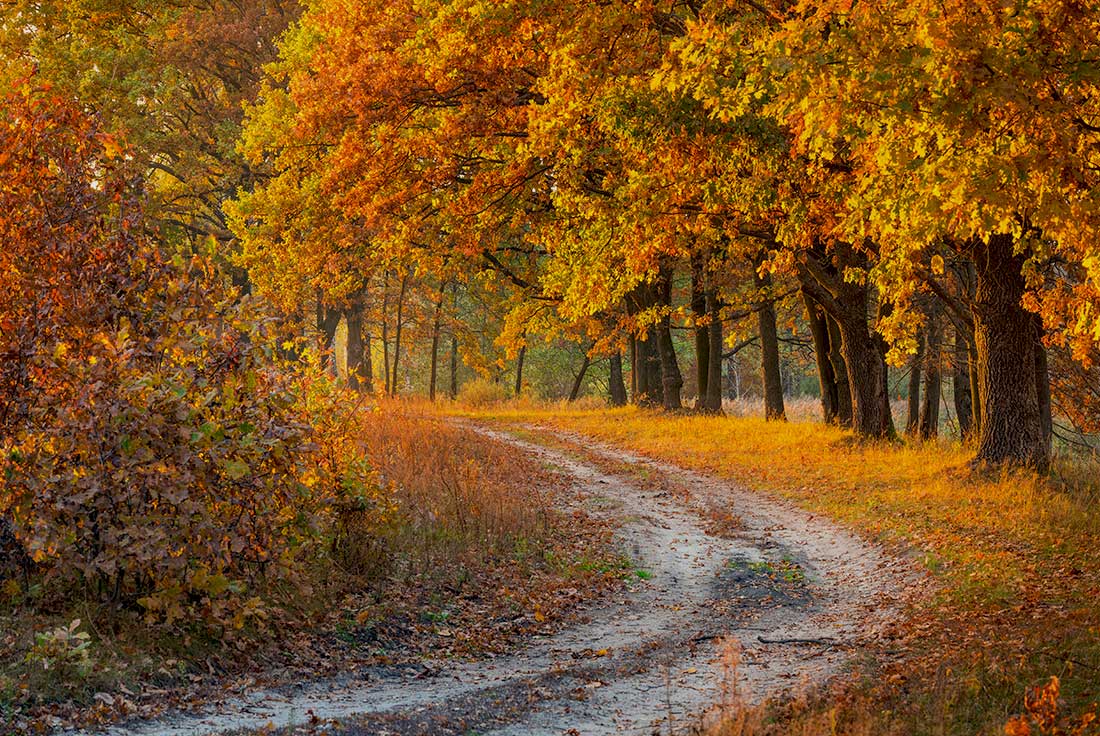By Kim Fogle
For photographers, Fall means beautiful light, and some of the most spectacular colors nature has to offer. Taking great photographs of autumn’s display takes more than merely pointing a camera at a stand of trees, so here are a few tips to help you capture this colorful season.
Arrive Early and Stay Late

Soft, warm light is ideal for autumn photography, and can most often be found during The Golden Hour, the hour after sunrise and before sunset.
This period of time is excellent for photography, as the flattering light adds drama to landscapes and backlighting leaves and trees. A benefit of arriving early and staying late is that you will avoid the crowds, as well.

Believe it or not, rainy overcast days also provide excellent light and help saturate color in a Fall landscape. Avoid photographing on sunny days when the sun is high in the sky as this type of light is harsh and causes unflattering shadows.
Long Exposures

Long exposures of leaves in the wind can produce an impressionistic effect in your images. This can be particularly striking if the leaves’ movement is set against something unmoving, like tree branches or rocks. With slow shutter speeds of a few seconds or longer, you can also enhance water flow and give a rocky stream a dreamlike effect, especially dramatic if there are colorful leaves in the scene.
To make a long exposure in a photo, you will need a sturdy tripod to stabilize the camera and a remote shutter release so you don’t shake the camera and cause unwanted blur. You might also want to invest in a circular polarizing filter to cut down on glare and enhance color or a neutral density filter to lengthen the exposure's duration to heighten the effects of moving water, leaves, or even clouds.
Composition
Avoid lackluster images by using a few tried and true composition tricks to make your autumn photographs dynamic. The most basic one is the rule of thirds. Divide your field of view by two horizontal lines and two vertical lines to create nine boxes. Place the subject of your photograph where a horizontal and vertical line intersects.


Another composition trick that works well is leading lines, which takes an element such as a road, fence, or tree line and leads the viewer's eye to the subject and creates depth in an image.


Also, consider using framing techniques to isolate the viewer's eye around the subject. In autumn photography, colorful trees surrounding an element such as a body of water, animal, or abandoned barn works beautifully.

Isolate Colors

Fall color isn’t all about the sweeping mountain views full of bright yellow aspens or a swath of red sugar maples. The little things are beautiful, too. Try isolating a single leaf with a macro lens or use a telephoto lens to capture a cluster of backlit leaves. A wide-angle lens is also handy for those wide shots of a tree line or colorful grove.

Color Balance

If you can, set your camera to landscape scene mode. This will usually give you a little more richness of color. I like to put my cameras to “Cloudy White Balance” as well-even in sunny conditions to add a bit of amber or warmth to the image.

Post-Processing for Enhanced Fall Colors
After capturing your fall images, don’t forget the magic of post-processing. Adjusting saturation, vibrance, and contrast can make autumn colors pop even more. Tools like Lightroom, Photoshop, or even the popular app Snapseed allows you to bring out rich reds, oranges, and yellows, making your photos stand out.
Fall only comes around once a year, so be sure to set aside some time to go outside and take in the beauty that nature has to offer and don’t forget to bring your camera! If you need inspiration on where to go, check out our list of local outdoor photography locations for Eastern Nebraska.
Looking for more tips on fall photography? Check out this blog post!
Gear List
- DSLR, Mirrorless Camera, Or Digital Compact Camera
- Wide-Angle Lens to capture wide landscapes.
- Telephoto Lens to isolate a subject such as a leaf or animal.
- Macro Lens or Extension Tubes for Macro Images.
- Lens Filters for protection and a variety of effects, such as color enhancement or motion blur.
- Monopod or Tripod for stabilization of long lenses or slow shutter speeds.
- Photo Gloves to keep your fingers warm and nimble.
- Backpack to carry your gear comfortably.




